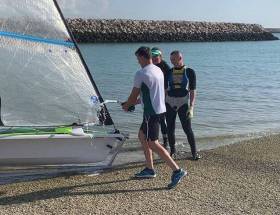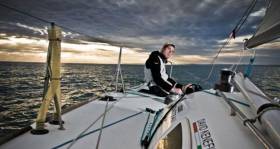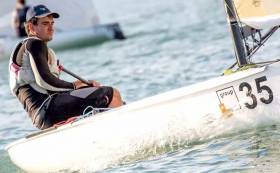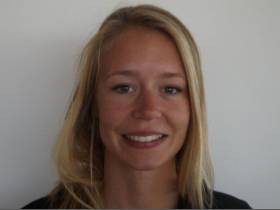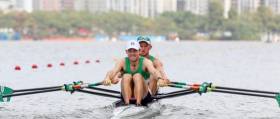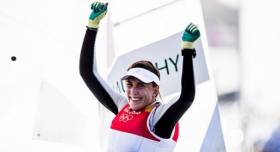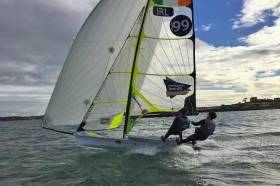Displaying items by tag: Olympics
A Toast For Annalise As Her Winter Training Begins In Cadiz
Mexican Laser sailor Yanic Gentry helped Annalise Murphy christen her new boat on its first day out on the water in Cadiz for winter training yesterday (Thursday 15 November).
The Olympic silver medalist announced earlier this month that she and her 49erFX partner Katie Tingle would be on the move to “somewhere warmer” after spending recent months getting to grips with the class on Dublin Bay — a situation that paused in the autumn due to Katie's arm injury.
While Katie is still on the mend, Annalise could not have have picked anywhere better than the Andalusian coast, near the gateway to the Mediterranean, to make every day count in her campaign to qualify for the 2020 Olympic Games in Tokyo.
Irish Sailors Eye New Olympics Mixed Keelboat Event With Interest
As reported earlier today, World Sailing’s AGM confirmed the inclusion of a new Mixed Two-Person Keelboat event to replace the previously agreed Mixed One-Person Dinghy at the Paris Olympics in 2024.
The International Finn Association has released a statement on the decision, which for now means the removal of the Finn class (indicated at the male equivalent in the Mixed One-Person Dinghy) from future Olympic Games after Tokyo in 2020.
Details have yet to emerge as to what boat will be used by those competing in the new mixed keelboat event, and evaluations may to be concluded by the Equipment Committee by next summer’s Mid-Year Meeting.
However, the development has already sparked interest — if not necessarily a desire to take part — among Irish keelboat sailors at the highest levels.
Thomas Dolan said he has the Paris Olympics squarely in his sights “especially as I should have a few years’ Figaro behind me by then”.
But the mixed keelboat news came as a surprise to the solo sailor, who had thought the idea to be a “dead duck” before last week’s announcements.
Meanwhile, David Kenefick admitted that he has “never had much desire” to go the Olympic route — though “if there was a Moth that might change”.
He added: “It would also be interesting to see what an offshore Olympics class would be like.”
However, Kenefick cautioned that as much as it’s an idea he would like to see, “I think it would be very expensive and with a low attendance" for 2024 at least.
#Finn - The International Finn Association (IFA) has spoken out over World Sailing’s unexpected decision to replace the Mixed One Person Dinghy event with a two-person keelboat class for the 2024 Olympics in Paris.
The 11th-hour change was made on the eve of the 2018 World Sailing Conference in Sarasota, Florida this week.
It overturns a previously agreed submission from this past May that had confirmed the mixed class — with the Finn indicated as the male equivalent — as a new event for the Paris Games.
In a statement, the IFA said the last-minute switch “is further driving our sport into expensive elitist Olympic events which will result in the decrease of universality and participation in Olympic sailing.”
The full statement by the Finn class can be read HERE.
Ireland has two Finn sailors — Fionn Lyden and Oisin McClelland — vying for a spot at what looks now to be the final Olympics for the class at Tokyo in 2020.
Sailing & Rowing Get Sport Ireland Funding Boost As Rio Review Says Ireland Falls Short
#Tokyo2020 - Funding for Irish sailing and other watersports remains broadly unchanged in Sport Ireland’s allocations for National Governing Bodies in 2017 — though programmes encouraging women in rowing have received a boost.
However, the accompanying review of the Irish Olympic performance in Rio acknowledges that Ireland's medal target was not reached – raising questions of expectations for Tokyo 2020.
The report highlights that Ireland “does not fund sport seriously”, according to Irish Times sportswriter Johnny Watterson, who cites the absence of long-term funding in favour of annual, non-guaranteed allocations.
More than €20 million for sporting bodies and athletes, in line with last year’s allocations, was announced by Minister of State for Sport Patrick O’Donovan this week as Sport Ireland also published its review of the 2016 Olympic Games in Rio.
The 2017 investment comprises €1.8 million in direct athlete investment; €7.2 million in high performance programme funding; €10.8 million in National Governing Bodies core funding; and €600,000 for the Women in Sport Programme.
The Irish Sailing Association (€323k), Rowing Ireland (€210k), Irish Surfing Association (€65k) and Irish Underwater Council (€60k) will get sums unchanged from 2016, though Canoeing Ireland sees a cut in its allocation by €10,000 (€205k to €195k).
Sailing (€18k) and surfing (€7,000) also see unchanged sums for their Women in Sport programmes, but Rowing Ireland receives a boost to €45,000 from €35,000 in 2016.
Sport Ireland highlights that more than 15,000 women and girls participated in Rowing Ireland’s ‘Get Going Get Rowing’ programme last year, while over 300 took part in the Irish Surfing Women in Sport initiative, and more than 9,000 availed of the Swim Ireland programme for female participation.
In allocations for high performance programmes, the ISA’s share rises by €100,000 to €735,000 for 2017, while Rowing Ireland sees an even bigger boost in its HP grant from €400,000 last year to €525,000.
Canoeing Ireland, however, sees its HP allocation cut by almost 40% to from €65,000 €40,000.
Welcoming the increase in sailing investment, ISA high performance director James O’Callaghan called for perspective on the figures involved.
“We’re pleased with the €100,000 increase but the truth of the matter is we started off the year with a €60,000 deficit because of the cost of [competing in] Rio. So really, it’s status quo for sailing,” he said.
Athlete investment
In direct athlete investment, 16 international athletes are awarded ‘Podium’ funding for 2017 under the International Carding Scheme.
In rowing, Rio Olympic medallists Gary and Paul O’Donovan, along with Sanita Puspure, will each receive €40,000 in Podium funding, while Rio’s Laser silver medallist Annalise Murphy is the only sailor to qualify for that funding level.
Sinead Lynch, Claire Lambe (€20k each), Mark O’Donovan, Shane O’Driscoll and Denise Walsh (€12k each) round out the rowing recipients in the 2017 funding round.
Among other sailing recipients, Ryan Seaton and Matt McGovern each receive €20,000, Finn Lynch gets €12,000 and €16,000 goes to crew/transition athletes.
In canoeing and kayaking, Patrick O’Leary (para canoe), Tom Brennan, Liam Jegou, Jenny Egan and Michael Fitzsimon will each get €12,000 of International level funding.
Sailing ‘must diversify’
Meanwhile, Sport Ireland says its Rio Review provides a “blueprint” for campaigns heading into the Tokyo Olympics in 2020.
In sailing, two of Ireland’s four classes competed in Rio “performed at or near expectations”, with the others cites for “credible results”.
The report adds: “Given it has been 36 years since Ireland last won an Olympic medal, this is an extremely exciting achievement and provides evidence of the success of the longer term strategy that ISA has been following for many years now.”
In its recommendations for sailing going forward, the report says work is underway “to diversify income to support the performance programme.
“In sports like sailing with significant capital needs, allocating funding on an annual basis is unhelpful. The sport and the athletes would be far more able to launch and deliver credible and performance based campaigns if funding was known over a longer period.”
However, the report also suggests that care must be taken by the ISA to remain within its budget allocation or “consider how difficult decisions might be made to invest in classes
with realistic chances of medalling” or other significant success.
Sailing would also benefit from more class competition within Ireland, the report adds.
“The review has identified the timescale to remedy the problems [within sailing],” said the ISA’s O’Callaghan. “But when are we going to see action to fix it?”
The picture for rowing is also less rosy, as Sport Ireland says “a lack of development structure and pathway is preventing the identification and progression of rowers to international
level”.
Despite that warning, Sport Ireland remains confident that “the current situation of recent history and success within this Olympic cycle represents a very strong position to be in.”
Consistency in training camps and post-training sessions is recommended by the report, which also suggests the use of biometric data to inform team performance.
The full Sport Ireland Rio Review is available as a PDF to read or download HERE.
Lambe Makes History as Cambridge Win Boat Race
#Rowing: Claire Lambe became the first Ireland international to win a women's Boat Race today. The Olympic oarswoman was in the three seat of the Cambridge boat which defeated Oxford easily in a race dominated by Oxford’s awful start. Their number four woman, Rebecca Esselstein, could not clear the water with her oar at the start and by the time the crew recovered the race was gone. Cambridge started well and won much as they liked.
They set a new record for a women’s crew (18 minutes 34 seconds) since the women’s race moved to London three years ago. The Cambridge coach, Rob Baker, is the former Ireland under-23 coach. “They were ruthless in the way they executed today,” Baker said.
Olympic Silver Medallist Annalise Murphy Is Irish Sailor Of The Year 2016 (Updated with Photo Gallery)
#SailorOfTheYear – Olympic hero Annalise Murphy has been named Afloat Irish Sailor of the Year for 2016.
August’s Sailor of the Month for her silver medal victory at Rio 2016 was presented with her prize by Irish Sailing Association (ISA) president David Lovegrove at the Volvo Irish Sailing Awards gala in Dublin’s RDS Concert Hall this evening (Friday 27 January).
Murphy was saluted by more than 300 of her fellow sailors, one of Irish sailing’s largest ever turnouts, for her Olympic triumph in the Laser Radial class – Ireland’s best achievement in sailing at the Games since David Wilkins and James Wilkinson won the Flying Dutchman silver at Moscow 1980.
That the National Yacht Club stalwart rallied from her heartbreak at London 2012, where she just barely missed out on a bronze medal, with an incredible display on the waters of Guanabara Bay made her success all the sweeter.
As Afloat.ie’s WM Nixon wrote in November, Murphy’s Olympic performance came after a 10-week transformation on the heels of a poor showing at the 2016 Worlds in Mexico:
“With her dedicated support team, she ensured that she’d become a hugely improved sailor, a fitter athlete and psychologically in a very good place, as she took on the Olympic challenge on August 8th with a cool confidence which in due course received its proper reward.”
It was an achievement that rightly captured the public’s imagination, too, providing Irish sailing with the greatest mainstream profile it’s enjoyed in years.
It’s already seen her recognised as The Irish Times/Sports Council of Ireland Sportswoman of the Year, Irish Tatler’s Woman of the Year, the Evening Echo’s Sports Star of the Year, and as one of Rehab’s two Sportspersons of the Year, not to mention her honorary membership of the Irish Sailing Foundation.
So it was surely to be expected that ‘Our Annalise’ would capture the public vote on Afloat.ie, as well as the votes of the judging panel to earn the prestigious award for a second time upon its 20th anniversary – two decades after first honouring that year’s own Olympic dinghy hero Mark Little, and four years on from her first win in recognition for her stellar efforts in London.
Accepting her prize, Annalise Murphy said: “As a kid I learned that maybe I wasn't the most talented, but I worked the hardest and that’s how I handled my sailing at the Olympics, and that’s what I’d advise all sailors to do now.”
Adding that the standing ovation from the ISA “means a lot to me”, she noted that it was “great to see all the Irish sailing achievements here, and that’s what I love in our great sport. It’s not all about the racing.”
Racing is still very much on Annalise’s agenda, however, with the first stage of her Tokyo 2020 campaign set for the Laser Radial Worlds this August.
Annalise’s accolade must also be seen in light of her fellow deserving nominees, all winners of Afloat.ie’s Sailor of the Month awards, and all of whom made remarkable and significant contributions to Irish sailing throughout the year.
Among them are a GP14 world champion in Shane MacCarthy, a Round Ireland record by Damian Foxall, a pioneering Vendée Globe effort by Enda O’Coineen, and youth sailor and future Olympic medal prospect Finn Lynch.
Irish sailing’s next generation was recognised in its own right on the night with the presentation of the Youth Sailor of the Year prize to Afloat’s racing Sailor of the Month for July, Ewan McMahon, alongside the Training Centre of the Year gong that this year went to Foynes Yacht Club, and two ISA President’s Awards – to Scottish Series racer Colin Moore, and Annalise Murphy's coach Rory Fitzpatrick, the latter of whom said of his eventful year: “It’s not just the Olympic result, it’s the inspiration of Annalise’s discipline routine in Dun Laoghaire that drives on our Laser sailors.”
In his address earlier this evening, ISA president David Lovegrove said he was “bowled over by the achievements of our sailors both at home and abroad.
“For such a small country, we achieve great things and our sailors are truly inspirational ambassadors for our sports and our country. 2016 was a year to make us all proud.”
But Lovegrove also took time to “celebrate the everyday heroes in sailing who don’t always get recognised by awards and cups – the volunteers who dedicate so much time, energy and passion to our sport, and who share their knowledge and expertise with other sailors.
“From the race officials to the instructors, to the coaches and the mark layers, the safety crews and those who carry out a multitude of tasks onshore: we simply could not enjoy sailing the way we do without you. Thank you.”
Hosted by master of ceremonies Fiona Bolger, chief executive of Spinal Injuries Ireland, along with Lovegrove and Afloat.ie’s own WM Nixon, the evening welcomed guests including members of the ISA Olympic and youth sailing squads, training centre principal, national senior and youth champions, class captains and club commodores, and a number of past Olympians and Sailors of the Year.
Great night @Irish_Sailing #Volvosailingawards celebrating our win with Irish Sailor of the Year @Annalise_Murphy pic.twitter.com/ePsrX1QUTy
— Clontarf Y&BC (@TarfYBC) January 27, 2017
Among the crowd were the Royal Cork's Sally O’Leary and her husband Anthony, 2010's Sailor of the Year, who are looking forward to the club’s dinghy fest, along with a band of club mates including Gavin Deane, Admiral John Roche and Rear Admiral Kieran O'Connell and Tom Durcan, who has just welcomed home his son Johnny from Australia, and Ted Crosbie who recently retired from racing.
Brian O’Sullivan and Francis Clifford represented Tralee Bay Sailing Club in the audience this evening, while Paddy Boyd, who was returned from a stint as CEO of Sail Canada, was also present, as were Chris and Sandra Moore of the Dublin Bay Sailing Club, Peter Ryan of ISORA, ICRA Commodore Simon McGibney from Foynes Yacht Club, and Martin McCarthy of Annalise’s home club, the National YC in Dun Laoghaire.
Others in attendance included Cormac Devlin, Cathaoirleach of Dun Laoghaire-Rathdown County Council, and Sport Ireland chief executive John Treacy.
O’Donovan Brothers Are RTÉ’s Sport Team Of 2016
#Rowing - Paul and Gary O’Donovan were last night named Team of the Year at the RTÉ Sport Awards, as RTÉ News reports.
The Olympic silver medallists in the lightweight double sculls in Rio this summer captured the hearts of the nation with their light-hearted post-race interview and subsequent appearance on The Late Late Show with fellow Olympic hero Annalise Murphy.
And just like Murphy, who added The Irish Times/Sports Council of Ireland Sportswoman of the Year award to her long list of accolades on Friday (16 December), the Skibbereen rowing brothers (and Afloat.ie Rowers of the Month for August) show no signs of resting on their laurels.
"We’re young yet, we’re only starting out hopefully," said Paul on the night. "We’ve got a taste of success now, so we’re going to capitalise on it."
Indeed, his brother Gary was back in the boat just hours before the awards ceremony for the Ireland Assessment at the National Rowing Centre — Paul only missing out due to Christmas exams.
Annalise Is Sportswoman Of The Year
#Annalise - 2016 draws to a close with another accolade for Ireland’s Olympic hero Annalise Murphy, who was named The Irish Times/Sports Council of Ireland's Sportswoman of the Year in Dublin this afternoon.
The Laser Radial silver medallist was Sportswoman of the Month for August, the same month of that outstanding achievement for Irish sport in Rio de Janeiro.
And that’s not counting her Sailor of the Month nod from Afloat.ie in August, as well as Irish Tatler’s Woman of the Year gong last month, her honorary membership of the Irish Sailing Foundation, the Sports Star of the Year Honour at last night's Echo Sports Awards, and a share of Rehab’s Sportsperson of the Year Award.
The last one she couldn’t accept in person as she enjoyed a well-earned break, dabbling in her ‘hobby’ of Moth sailing at competition level in Bermuda.
That dedication to her craft — which included a 24-hour whirlwind round trip to bring home her medal-winning dinghy — is what we’ve come to expect from our Annalise over the years.
And this latest award shows how the rest of Ireland’s sporting world is catching on. Well done, Annalise!
More from David O'Brien in the Irish Times HERE
Irish 49er Duo Launch Crowdfunding Campaign For Tokyo 2020 Ambitions
#49er - More than €5,000 is the cost of competition for Ryan Seaton and Seafra Guilfoyle as they prep for their first event as a duo in Mallorca this coming spring.
The new combination have joined with PledgeSports to crowdfund the necessary budget for a new 49er skiff plus flights, accommodation and ferries as they ready for their debut competition event in the Balearic Islands.
Ahead of that, they will be training with other Olympic hopeful teams and coaches in Cadiz and Mallorca in preparation for a season that builds on a tremendously successful 2016 for Irish high performance sailing.
As previously reported on Afloat.ie, last month double Olympian Seaton teamed up with 20-year-old Royal Cork prospect Guilfoyle, making his comeback from an injury that ruled him out of last summer’s Olympics, with ambitions to represent Ireland in the skiff class at Tokyo 2020.
But they will face strong competition for that spot, not least from Seaton’s former partner and fellow Belfast sailor Matt McGovern, with whom he finished in the top 10 in Rio, who is also currently looking for a new skiff partner.
More on the €5,350 Seaton and Guilfoyle are looking to raise can be found on the PledgeSports website HERE.
Annalise Brings Home Olympic Medal-Winning Laser Dinghy
#Annalise - After a whirlwind 24-hour round trip by ferry and road to Britain this week, Annalise Murphy has returned to Ireland with the boat she sailed to a silver medal at this summer’s Olympic Games in Rio.
The idea of taking ownership of the historic Laser Radial dinghy was first mooted by our own WM Nixon back in August, and quickly gathered pace as Jim Cusask talked up the notion for the Irish Independent.
Here’s hoping Annalise and team have plans to let the public get a closer look at the dinghy she raced to success on Guanabara Bay at Rio 2016.
A 24hr round trip to @LaserPerform to pick up my boat from the Olympics! @Irish_Ferries got me safely home at 6am this morning! pic.twitter.com/WIH8iTFyBE
— Annalise Murphy (@Annalise_Murphy) November 29, 2016



























